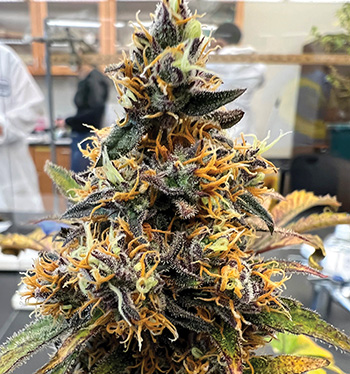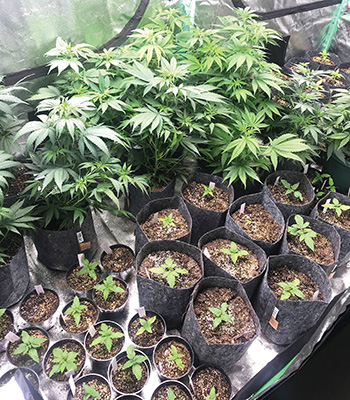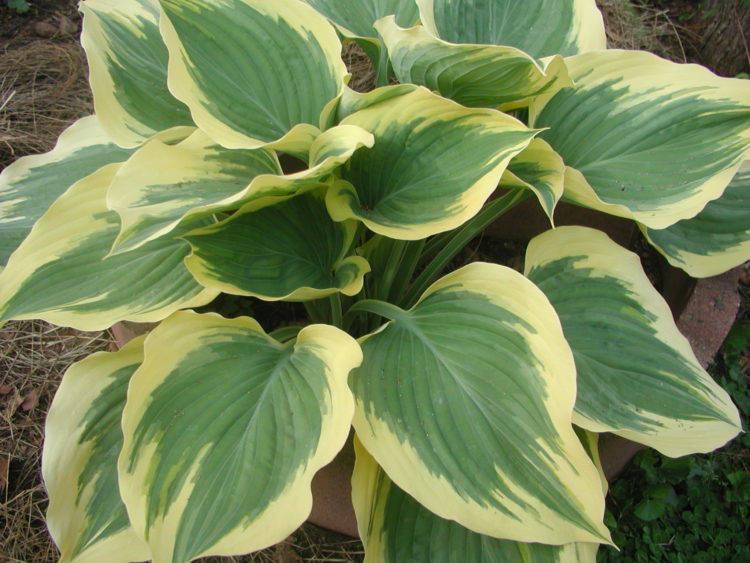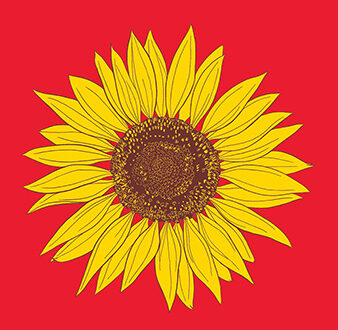By Bryan Connolly
This article has the home growers as the target audience. There is a process to apply for a commercial THC cultivation license that can be viewed at https://bit.ly/3CG3wZM
Know the rules: check the regulations on the State of Connecticut website before you grow your own: https://bit.ly/3ICgNGp
In short, no THC plants can be grown outdoors in Connecticut. They must be grown in a secure area and not visible from the outside. An individual over 21 can grow 6 plants; 3 can be mature or in flower and 3 immature or vegetative. Only 12 plants are allowed per household, so if you have 3 people over 21, only 12 plants (6 immature and 6 mature) can be grown.
The public cannot grow Cannabis until July 1, 2023. Medical Marijuana patients can currently cultivate plants, the rules for that program can be found at https://bit.ly/3W4vV2c

Maturing female plant grown at Eastern Connecticut.
Getting Set Up
The easiest way to start indoor growing is likely with a grow tent. These can be purchased as a kit and include most of what you’ll need. Grow tents come with the following:
• Snap-together frame and reflective zippered tent cloth. Provides an enclosed environment and reflects light back into the tent for greater efficiency.
• Lights, generally LED (light emitting diode), are the most commonly used type of indoor light for the home grower. They have good light output, are energy efficient, and don’t produce a ton of heat. In a kit the lights are sized appropriately for the kit. Currently I use 2 × 400W LED lights in a 4′ × 8′ tent.
• Fan with carbon air filter for circulation and also odor reduction. Yes, Cannabis plants do have that typical Cannabis smell while they are growing.
Not always provided with tents but needed are extension cords, light timers, thermometer, humidity meter and something to support plants when near maturity. Those buds get heavy! Pots are occasionally included.
Almost never included is growing media/potting soil. I’ll cover growing media later.
Tents can be purchased online. Amazon offers several grow tent kits. AC Infinity, Gorilla Grow, Spider Farmer, and Vivosun are all brands offered online. I suggest reading the reviews. Additionally, Connecticut has several hydroponic stores that have grow tents in stock if you want to see them in person. If you are going to grow 6 plants with 3 being mature, you will need at least a 4′ × 4′ tent, if not larger.

Plants cultivated in a grow tent at Eastern Connecticut State University.
Connecticut Hydroponic Stores
Hydroponic stores generally carry Cannabis growing supplies. Below are some in Connecticut. These are good places to talk with people about Cannabis growing and to look at or purchase supplies and equipment.
• HTG Supply Hydroponics & Grow Lights in Orange
• Mr. Nice Guy Hemp & Garden Supply, Wolcott
• Harvest Moon Hydroponics, East Hartford
• CT Home Grown, Canterbury
• Green Valley Hydroponics, Putnam
• Shoreline Hydroponics, Westbrook
There are additional stores in neighboring states that may be closer to your home than those above. Again, you may want to peek at the reviews before paying the stores a visit.
Soil & Pots
Soil – In nature, Cannabis prefers a light, well-drained soil. There are several companies that now make soil blends that are appropriate for Cannabis. These again can be ordered online or are available either at regular garden stores or hydroponic stores. Promix HP, FoxFarm Ocean Forest, and Coast of Maine Stonington Blend are common and available growing media that work well for Cannabis.
Pots – Plastic and clay pots are used for Cannabis but, because of the plant’s preference for well-drained soils, cloth pots are also often used. For autoflowering strains it is generally recommended to plant directly into a 3-gallon pots. Transplanting is possible but it must be timed correctly.
I personally use 2-gallon felt pots for the auto CBD strains I grow at Eastern Connecticut State University. These need to be watered and fertilized more frequently than the 3-gallon pots but they also are less prone to the soil getting waterlogged.
For photoperiod plants I start them in 3″ plastic pots. When the plants begin to get root bound, I move them up to 2-gallon pots, and then I move them one last time to 5-gallon pots.
Fertilizer – Cannabis is a picky plant and nutrient deficiencies are a common issue. There are many fertilizer types available online or at hydroponics stores. They are formulated for the different parts of the Cannabis life cycle. There will be a higher nitrogen mix for the vegetative phase and low-nitrogen, high-phosphorus blends for the flowering part of the grow cycle.
There are several nutrient lines available, e.g., Jack’s, General Hydroponics Flora Grow, FoxFarm, etc. Generally, after a few weeks, even with good potting soil blends, Cannabis will need some sort of nutrient feeding. There are several charts online and also in books that illustrate the symptoms of common nutrient deficiencies in Cannabis. Most growers also flush their soil at the end of the grow cycle; the idea is that it reduces the chlorophyll and mineral content of the crop. The flush is supposed to make Cannabis smoke less harsh on the throat.
Hydroponics is commonly used by Cannabis growers. For now, I will skip this topic. This could be a topic of another Cannabis article in the future.
Seed Strain Selection & Ordering
If you don’t get good genetics, no matter how well your plants are taken care of, you won’t get the results you want. There are a number of companies that sell Cannabis seeds online. They are often referred to as seed banks. Cannabis seeds are considered “souvenirs” and are generally legal to send between states and countries. Some companies will go through extra steps to hide the identity of the package contents, if you’re worried about people knowing you grow Cannabis. There is a seemingly endless variety of Cannabis strains available and selecting a strain can be overwhelming.
First you need to decide what cannabinoid you want: CBG, CBD, THC, or a CBD/THC mixed strain. Additionally, you’ll have to figure out how high a percent of the cannabinoid you desire.
Do you want feminized seed or regular seed? Feminized seed will produce almost all females so you don’t waste time and resources growing males, but it is often more expensive, about $10 a seed for small batches.
Regular seeds will have both male and female plant. It is sometimes cheaper, though the selection of strains as regular seeds is declining since many people are choosing feminized seeds. Regular seed is easier to grow your own seed from if you choose to produce a seed crop instead of a sinsemilla crop.
The choice must be also be made between photoperiod and autoflowering. Again, photoperiod plants have a long-day vegetative period where you keep the lights on 18 hours a day while giving them high nitrogen for 4-10 weeks, then they are switched to the flowering stage of 12 hours of light and high phosphorus for 6-8 weeks.
Autoflowers will flower with any length of light, they just need enough energy to photosynthesize and grow. They’ll need a minimum of 12 hours a day (18 hours a day is probably ideal). There’s no need to switch lighting cycles with these plants. Autos will flower automatically when they reach a specific size based on strain.
In the end you can mix and match all the above categories to get the type of Cannabis strain that suits you. You can purchase a THC, auto, regular strain, or a THC, photo, feminized strain, or a CBD, auto, regular, etc. The criteria are independent of each other.
Generally, each strain will have a written description that includes potency but also the aroma and flavor of the terpenes. Many companies will also have a lab certificate of analysis (COA) for each strain with their descriptions.
Fortunately, many of the sites have filters so you can see only the selections that interest you. For example, you can filter for autoflowering mid-percent CBD/THC mixed strains, and only those options will be shown.
Many Cannabis seed companies are based in Europe and, unfortunately, they often don’t sell overseas, but Seedsman is a company with hundreds of strains that ships to the US. Additionally, in New England there is the North Atlantic Seed Company based in Maine. There are many, many other companies but again, check reviews as the companies may or may not be reputable.
• https://www.seedsman.com
• https://northatlanticseed.com
Germination
High quality Cannabis seed will have a dark brown seed coat that isn’t easily crushed with pressure between your index finger and thumb. Seeds should not be whitish or light green. Generally, good quality fresh Cannabis seeds have a high germination rate. Seeds are planted about ¼” deep in moist soil, germination generally occurs within a week. Pre-soaking in water or a light scarification with sandpaper may speed germination rates. Seedlings will not develop the characteristic palmately compound leaf until they have grown a few nodes.
Starting from Clones/Cuttings
Photoperiod Cannabis strains can easily be propagated by cuttings in the vegetative stage. The rooted cuttings are referred to as clones. You can save money by cloning and you can also continue the life of a superior plant. There are businesses where clones can be purchased as well, be sure to check the State of Connecticut website for regulations.
Cloning is an easy process, just clip a branch about 6″ long from the desired plant. A standard IBA (Indole-butyric acid) rooting hormone works, e.g., Hormodin 1. I often use the Clonex brand gel for Cannabis.
I either stick the cutting in a rapid rooter or similar plug and place it in a humidity dome. Alternatively, you can use a water cloner, basically a plastic bin filled with about 6″ of water with an aquarium bubbler and a lid designed to hold cuttings, e.g., Oxyclone. Roots develop in 1-2 weeks.
Clones generally work well, but be sure to take them from healthy plants. Insects and diseases can come with the cuttings. Cloning autoflowering Cannabis generally does not yield good results. Clones are usually grown under lower light, e.g., fluorescent lights, for a week or two until roots are established before placing them under high-powered LEDs
Watering
Cannabis is sensitive to overwatering, so most growers keep their plants on the drier side, allowing for drying between waterings.
Pest & Diseases
Cannabis can have several disease and insect issues. If you are growing indoors, sanitation will be the best way to keep your crop healthy. At Eastern Connecticut State University my students and I work in our isolation tents first thing when we arrive and then go to the main greenhouse, we never visit the greenhouse first. We also wash or clean our clothes and shoes if we visit another Cannabis facility before we work with our plants again.
Adult insects, eggs, spores, etc., can easily be transported on people. We try not to move plants or clones into the tents without a strict quarantine and inspection. House plants could be a potential source of insect problems. Most common greenhouse insect pests can be a problem on Cannabis. Aphids, whitefly, and scale are common. These three are manageable with a combination of soap sprays, sanitation (removal of infected foliage or plants), and the appropriate beneficial insects.
The two-spotted spider mite is the biggest insect pest problem I have seen on Cannabis. I’ve attempted management with mixed success using beneficial mites, soap sprays, sanitation, and neem. Isolating your crop from infected areas and cleaning your growing area is likely the best way to avoid spider mite problems.
As for disease problems, powdery mildew can be devastating, but if caught early, potassium bicarbonate can be an effective treatment. Bud rot, or botrytis is a common problem on Cannabis flower. Management is largely environmental, maintaining good air circulation as well as the proper humidity and temperature levels. Viruses and viroids are also known issues and are likely to be spread by infected clones.
Pruning, Training, Defoliating & Trellising
You can just allow your Cannabis plant to grow as is, but most growers prune, train, and partially defoliate their plants. Cannabis, if left to grow in its natural form, will generally grow into a cone like a Christmas tree. When Cannabis plants reach about 3 or 4 nodes in height, most growers remove the top of the plant, akin to pinching basil.
The complete apical meristem can be removed, called “topping” or most of the new growth can be cut, called “fiming.” The term fiming comes from “f*** I missed,” meaning the apical meristem was not removed. Either technique causes the plant to form side branches.
Fiming is a little less traumatic for the plant. The goal of training is to flatten the plant and have it produce many colas (groups of female flowers), instead of just one. Training increases the productivity and exposes more of the plant to light, which increases the potency of your crop. Once side branches reach a few inches long they are trained.
There are two main ways of training, high stress and low stress. Low stress involves drilling holes in your pots and using twine to pull the branches down and away from the center part of the plant.
Many growers do not like high stress training, but it can be effective. For high stress training the branches are carefully crimped or kinked like a hose but not entirely broken. The side branches will partially lay down after this and heal in position, and the wounding site forms a “knuckle” which gives the branch added strength. High stress is not favored by many growers because it is easy to break branches and introduce a wound site where disease could enter the plant.
As Cannabis plants get larger and develop a dense canopy, many growers defoliate the lower portions of the plant to increase air circulation and prevent disease outbreak. One technique called “lollipopping” removes a great deal of the lower foliage. Defoliating also reduces self-shading and increases the overall photosynthetic efficiency of the plant.
Flowering
After about 4-10 weeks of vegetative growth, your light timers can be changed to 12/12 light/dark. Longer vegetative growth allows for a bigger plant and harvest but takes longer to get a crop. Photoperiod plants will show signs of flowering within a week or two of the light change. Females will have white upright feathery stigmas; males will have downward spherical flower buds.
Unless you are growing for seed, males should be removed as soon as their gender is determined. Also watch out for hermaphrodites, some plants are genetically predisposed to be hermaphrodites, and other plants can become hermaphrodites when stressed. Hermaphrodites should also be removed from the grow area. The colas will begin narrow and start to bulk up as they mature. As the colas get heavier the plants will need support. A horizontal trellis is often used. Many growers use what is called the screen of green technique (the ScrOG) to support a highly pruned plant with many colas.
Harvest Time
When is it time to harvest? Cannabis flower is ready when the stigmas (upright white part of the flower) turn orange, also the trichomes (the frost-like hairs on the female flowers) go from clear to cloudy. A magnifying glass or jeweler’s loupe may be useful to examine the trichomes.
The colas are removed from the plant and then the leaves are separated from the flowers. This is called trimming. The big palmate fan leaves have very low Cannabinoid levels and are generally discarded.
There are small simple leaves (not palmately compound) that grow between the flowers on the cola, these are called trim leaves. Trim leaves have some Cannabinoids but not as much as the flower. These trim leaves are removed, generally using florist pruning snips. The resin from the trichomes will make all harvesting equipment and you sticky, so it’s a good idea to wear rubber gloves and have some rubbing alcohol handy to clean tools. The trim leaves are dried and kept to make cannabutter for edibles or used for tinctures.
You can either wet trim or dry trim, there are differing opinions. For me it’s a matter of time when I can get the trimming done. Once harvested the colas need to be dried, they can be hung anywhere where is it cool, dry, with good air circulation and out of direct sunlight. The Cannabis will be very odiferous at this point and you may want to dry it where the smell won’t be a problem. Some people dry in an empty grow tent with the lights off but the carbon filter and fan running.
THC does degrade into another cannabinoid CBN if your harvest is dried or storage improperly or stored for a long time. This cannabinoid is therapeutic in its our right, used as a sleep aid, but will not have the psychoactive effect many people are looking for.
Once trimmed and mostly dried, your harvest can be cured. Like tobacco, Cannabis is stored with some moisture still left in it. You can put your mostly dry flower into canning jars or other storage containers at about 55-65% humidity. You can purchase a small humidity meter to place in the jar. The jars are opened or burped daily and the buds gently moved around for the few weeks, this along with the nutrient flush at the end of the grow cycles makes Cannabis smoother when smoked.
Learning How to Grow
In addition to books, there are several classes being offered at grow shops and dispensaries.
Recently higher education has gotten involved and is now adding Cannabis classes to the curriculum. I teach a Cannabis Cultivation class at Eastern Connecticut State University as part of our Cannabis Cultivation and Chemistry minor … easternct.edu/biology/programs-of-study/minors/ cannabis-cultivation-and-chemistry-minor.html
The University of Connecticut also offers courses in Cannabis cultivation. The University of New Haven and the Connecticut Community College system have Cannabis certificate programs.
In addition to teaching at UConn, Matt DeBacco occasionally offers a class on Growing Cannabis at The New York Botanical Garden (nybg.org).
If you are a gardener or commonly grow indoor house plants, with some practice and experimentation you’ll be able to figure it out Cannabis growing. Good luck and happy growing!
Bryan Connolly is an assistant professor in biology at Eastern Connecticut State University. Dr. Connolly is a botanist and horticulturalist. His research interests include rare plants of New England, the nightshade family, roses and Cannabis. He is a former president of the New England Botanical Society.





